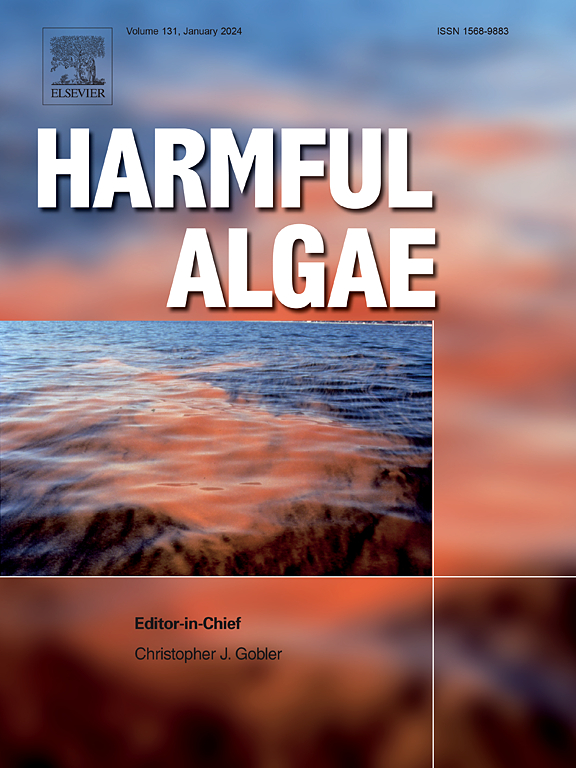蓝藻连通性从淡水到河口:洞察基因型和蓝藻毒素流
IF 4.5
1区 生物学
Q1 MARINE & FRESHWATER BIOLOGY
引用次数: 0
摘要
蓝藻繁殖是影响水质和生态系统正常功能的有害事件,特别是当产生毒素的物种占主导地位时。虽然蓝藻和蓝藻毒素自80年代末以来已经在陆海界面被报道,但关于内陆淡水如何影响这些系统中的蓝藻群落的遗传证据迄今为止非常缺乏。本研究旨在研究西班牙西北部水产养殖丰富的沿海地区内陆淡水水库和河口的蓝藻群落之间的关系。在2022年和2023年期间,围绕开花季节共开展了6次采样活动。通过16S rRNA基因的元条形码编码和基于pcr的蓝藻毒素生物合成相关基因筛选,分析了蓝藻菌群落及其潜在毒性。结果表明,水库可能是河口潜在有毒蓝藻存在的重要原因,超过80%的水库共享蓝藻asv(扩增子序列变异)属于潜在有毒属。在两个系统中均检测到与微囊藻毒素和安纳托毒素相关的基因,并伴有低毒素浓度。大多数关键的蓝藻属始终以特异性asv为主,这表明在运输过程中存在一些对环境梯度具有抗性的基因型。这些发现突出了淡水系统对河口蓝藻群落的影响,并展示了用于高分辨率监测的遗传工具的潜力,有助于生态和经济风险的水管理。建议进一步研究以了解蓝藻水华扩散对陆海界面系统的全球影响,特别是在经济相关地区。本文章由计算机程序翻译,如有差异,请以英文原文为准。

Cyanobacterial connectivity from freshwater to estuaries: insights into genotypes and cyanotoxins flow
Cyanobacterial blooms are detrimental events that affect the quality of water and the normal functioning of ecosystems, especially when dominated by toxin-producing species. Although cyanobacteria and cyanotoxins have been reported in the land-sea interface since the late 80s, genetic evidence on how inland freshwaters influence the cyanobacterial communities in these systems is very scarce to date. This study aims to investigate the relationship between the cyanobacterial communities of an inland freshwater reservoir and an estuary located in an aquaculture-rich coastal area of NW Spain. During 2022 and 2023, a total of six sampling campaigns were carried out surrounding the blooming seasons. Cyanobacterial communities and their potential toxicity were analyzed through metabarcoding of the 16S rRNA gene and PCR-based screening of genes involved in the biosynthesis of cyanotoxins. Results demonstrate that the reservoir likely contributed significantly to the presence of potentially toxic cyanobacteria in the estuary, with more than 80 % of reservoir shared cyanobacterial ASVs (Amplicon Sequence Variants) belonging to potentially toxic genera. Genes related to microcystins and anatoxins were detected in both systems, accompanied by low toxin concentrations. Most key cyanobacterial genera were consistently dominated by specific ASVs, suggesting the presence of a few genotypes resistant to environmental gradients during transport. These findings highlight the influence of freshwater systems on estuarine cyanobacterial communities and demonstrate the potential of genetic tools for their high-resolution monitoring, useful in water management of ecological and economic risks. Further research is recommended to understand the global impacts of cyanobacterial bloom dispersion towards land-sea interface systems, particularly in economically relevant areas.
求助全文
通过发布文献求助,成功后即可免费获取论文全文。
去求助
来源期刊

Harmful Algae
生物-海洋与淡水生物学
CiteScore
12.50
自引率
15.20%
发文量
122
审稿时长
7.5 months
期刊介绍:
This journal provides a forum to promote knowledge of harmful microalgae and macroalgae, including cyanobacteria, as well as monitoring, management and control of these organisms.
 求助内容:
求助内容: 应助结果提醒方式:
应助结果提醒方式:


